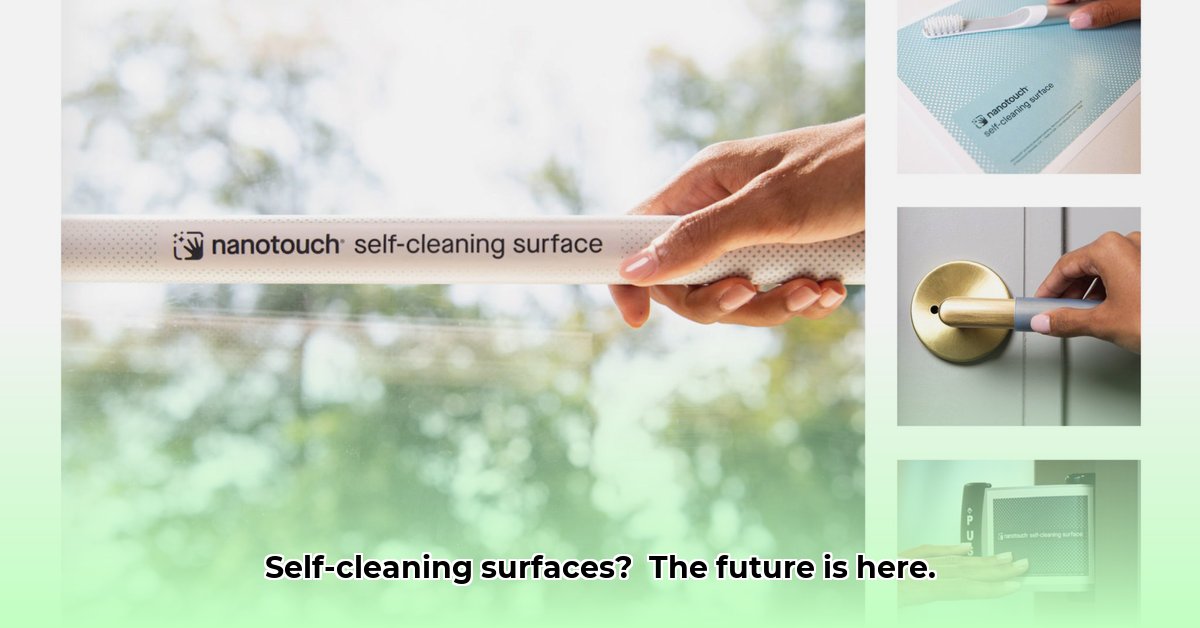
NanoTouch Materials and the NanoSeptic Revolution: Self-Cleaning Surfaces for a Cleaner Future
Self-cleaning surfaces represent a significant advancement in hygiene and sanitation, particularly within high-traffic environments such as hospitals, airports, and public transit. NanoTouch Materials' NanoSeptic technology stands at the forefront of this innovation, promising a revolutionary approach to maintaining cleanliness. But what exactly is NanoSeptic, and what are its prospects for widespread adoption? This analysis examines the technology's mechanism, market potential, associated challenges, and the path towards broader commercialization.
How NanoSeptic Works: Harnessing the Power of Nanocrystals
NanoSeptic leverages the power of specially engineered nanocrystals. These microscopic particles, when exposed to ambient light, trigger an oxidation reaction that breaks down organic matter, effectively cleaning the surface. This process can be visualized as a microscopic, self-perpetuating cleaning crew, constantly working to maintain hygiene. This inherent and continuous cleaning action represents a departure from traditional, intermittent cleaning methods. How effective is this continuous cleaning in real-world settings compared to conventional methods?
Market Potential: A Growing Demand for Self-Cleaning Solutions
Initial market response to NanoSeptic indicates significant potential. Surveys reveal strong consumer preference for businesses utilizing this technology, translating into enhanced customer perception and improved brand image. The adoption of NanoSeptic by numerous Fortune 200 companies and leading hotel chains underscores the technology's appeal within commercial settings. This significant adoption signals a growing market demand for long-lasting and effective hygiene solutions. What are the specific market segments driving this demand, and how effectively is NanoSeptic meeting these diverse requirements?
Challenges and Opportunities: Navigating the Path to Widespread Adoption
Despite its promising characteristics, NanoSeptic faces several challenges. Scaling production to meet the expanding demand poses a significant hurdle. Furthermore, the evolving regulatory landscape surrounding nanomaterials introduces uncertainties regarding compliance costs and potential regulatory roadblocks. Additionally, further research is needed to fully assess NanoSeptic's effectiveness in low-light conditions, a crucial factor for widespread applicability. How is NanoTouch Materials addressing these critical challenges to ensure the technology's continued success?
A Balanced Assessment: Weighing the Pros and Cons of NanoSeptic
A comprehensive assessment requires a balanced view of NanoSeptic's strengths and weaknesses:
| Feature | Strengths | Weaknesses |
|---|---|---|
| Effectiveness | Demonstrated effectiveness in high-traffic environments. | Reduced effectiveness in low-light conditions requires further investigation. |
| Market Appeal | Strong consumer and business interest. | Production scalability remains a challenge. |
| Technology | Innovative nanocrystal oxidation process. | Uncertainties related to long-term regulatory compliance. |
| Long-Term Viability | Growing customer base and expanding production capacity. | Long-term durability and maintenance costs require further analysis. |
The Path Forward: Strategies for Maximizing NanoSeptic's Potential
Realizing NanoSeptic's full potential demands a multi-pronged approach. Increasing production capacity is paramount. Proactive engagement with regulatory bodies is crucial to ensure smooth market access and long-term compliance. Continuing research into long-term performance and maintenance, as well as exploring new applications, is essential. Strategic partnerships, particularly with cleaning product manufacturers, can significantly expand market reach. Finally, global expansion will be key to unlocking the technology's full potential. What specific metrics will NanoTouch Materials use to track progress towards these goals?
Regulatory Compliance: A Critical Factor for Long-Term Success
Navigating the regulatory landscape for nanomaterials is complex and crucial for long-term viability. Regulations vary geographically, impacting manufacturing, labeling, and end-of-life management. A thorough understanding of relevant national and international standards is essential before production begins, encompassing aspects such as safety, environmental impact, and labeling requirements. What specific regulatory frameworks are most critical for NanoTouch Materials to address?
Achieving Long-Term Regulatory Compliance: A Step-by-Step Guide
- Comprehensive Material Characterization: Precisely defining the nanocrystals' properties (size, shape, chemistry, purity) is foundational for toxicity assessments and compliance.
- Toxicity and Environmental Impact Studies: Thorough testing to evaluate potential health and environmental effects is mandatory, leveraging both in-vitro and in-vivo studies as necessary.
- Lifecycle Assessment (LCA): Thorough evaluation of environmental impacts across the product's entire lifespan, from sourcing to disposal.
- Regulatory Strategy Development: Proactive engagement with regulatory agencies and anticipating future changes.
- Continuous Monitoring and Adaptation: Continuously monitoring regulatory adjustments and adapting manufacturing processes to maintain compliance.
In conclusion, while challenges remain, NanoSeptic's market potential is significant. Its success hinges on addressing production scalability, navigating the regulatory landscape, and continuously improving the technology to meet evolving market demands. The future of this innovative technology appears bright, pending the successful execution of these critical strategies.